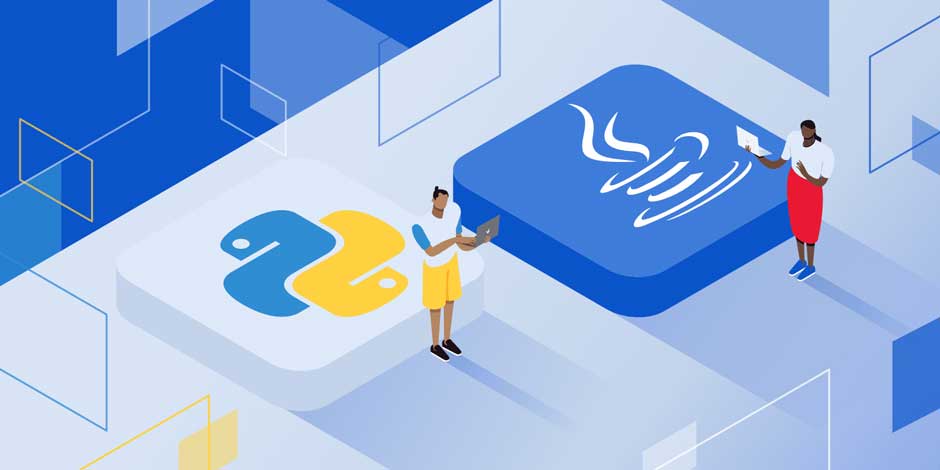7 Programming Courses (Java & Python) You Can Finish Online in 2025

Java and Python address the majority of the daily works of the engineer. Java is powerful on backend services, Android, Python is good on data work, automation and rapid scripts. The reason why the seven courses here are chosen is that you can comfortably complete the courses in 2025 and write code every week – not only watch videos. Every pick prefers obvious teachings and exercises thus you learn through doing.
This list is a kind of a study plan. Choose a lane, establish two fixed blocks per week of study and send one small artifact per week a tested class or a small REST API or a data-cleaning notebook or a small CLI tool. Commit your work to GitHub with a brief README. Install an IDE that is familiar to you (IntelliJ or VS Code) and configure Git at the beginning. Check your code at least once a week, write down what you learned and have your peer provide immediate feedback.
Factors to consider before you pick
- Career Goal: Select one of the following lanes backend, Android, data/ML, or general software engineering–and map the skills and tools that are relevant to it (e.g., backend → APIs, databases, deployment; Android → Kotlin, Jetpack; data/ML → Python, pandas, model ops). This helps to maintain the focus of your study plan and relevance of your portfolio to the jobs that you will be seeking.
- Learning style: Use mentor cohorts when you need deadlines, feedback and a peer group to hold you accountable; use self-paced videos + labs when you want to learn at your pace and you need to continue to make projects and that can be done at your own pace. Whichever way, focus on courses that have practical lab sessions and course projects.
- Budget/time:Subscriptions are cheaper and less variable because of their reliability in upskilling, quick win: Attract whenever you need more structure, evaluation, and brand signal: University/executive track is more expensive and time-consuming. Set achievable weekly hours in advance to avoid any stalling.
- Output: Deliver one artifact in the form of a mini-project, lab report, or code sample every week a mini-project (e.g., a REST API on the backend, a small Kotlin app on the Android), a data notebook/model on the ML, etc. Put it all into a portfolio repo, create brief READMEs, and get feedback on future learning by asking a mentor/peer.
1) Master Java Programming — Great Learning Academy (Pro+)
- Duration: ~16 hours
- Mode: Self-paced with guided projects
- Offered by: Great Learning Academy (Pro+)
A compact Java path from syntax and OOP to collections, I/O, and modern Java (lambdas/streams). Includes guided projects and certificate with Pro+.
Here’s why it stands out:
- Short, structured path you can finish in weeks
- Guided projects to showcase in a portfolio
- Certificate included with Pro+ subscription
Let’s peek into the curriculum:
- Java basics, OOP, exceptions, file I/O, collections
- Java 8+ features (lambdas, streams)
- 2–3 guided projects to apply concepts
Why opt for this program?
- You want a quick but substantive Java refresh with portfolio pieces
- You prefer simple, step-by-step guidance and a certificate
Course link: java programming course
Great Learning Academy Pro+ — Master Python Programming (Premium Course with Certificate)
Duration: ~11.5 hours of video
Mode: Online, self-paced with 51 coding exercises, 3 guided projects, and a mock interview
Offered by: Great Learning (Academy Pro+)
Price: Pro+ subscription (₹999/month) with a 7-day free trial; certificate included with Pro+
A compact, practice-first Python course designed to build job-ready skills fast. You learn core Python, OOP, RegEx, and exception handling through short videos, structured exercises, and three guided projects that you can showcase in your portfolio.
Here’s why it stands out:
- Hands-on by design: 51 coding exercises plus 3 guided projects to turn concepts into muscle memory.
- Career-oriented touches: a Python Developer mock interview to test your readiness.
- Affordable entry: 7-day free trial and ₹999/month Pro+ subscription that includes the certificate.
Curriculum Overview:
- Python Fundamentals: variables, data structures (lists, tuples, dicts, sets), conditionals, loops, and functions (35 videos + 19 exercises; ~3h40m).
- OOP in Python: classes/objects, inheritance, polymorphism, encapsulation (22 videos + 19 exercises; ~2h40m).
- RegEx in Python: meta-characters, functions, match objects (~1h33m).
- Exception Handling: try/except patterns, built-in & user-defined exceptions (~2h + 9 exercises).
- Guided Projects:
- Virtual Banking Application (accounts, transactions, payee management, records),
- Virtual Pet (state management, loops, file I/O),
- Wikipedia Extractor (web requests, parsing, data extraction).
Why opt for this program?
- You want a fast, structured path that moves from syntax to projects you can actually show.
- You prefer short modules with frequent exercises instead of long lectures.
- You like the clarity of a built-in certificate and a mock interview to finish strong.
Course Link: Python Programming course
3) Python for Everybody Specialization — University of Michigan (Coursera)
Duration: Self-paced
Mode: 5-course series with projects
Offered by: University of Michigan on Coursera
A widely trusted path from zero to building small apps that pull, process, and visualize data in Python; millions enrolled.
Here’s why it stands out:
- Clear explanations and steady difficulty curve
- Portfolio-oriented capstone work
- Available within Coursera Plus or via free audit
Let’s peek into the curriculum:
- Python basics → data structures → web data → databases → visualization
- Final capstone pulling it all together
Why opt for this program?
- You want a structured sequence with lots of practice
- You value a well-known university brand on your certificate
Java Programming & Software Engineering Fundamentals — Duke University (Coursera)
Duration: Self-paced
Mode: Multi-course specialization
Offered by: Duke University on Coursera
A Java-first route into software engineering foundations—algorithms, testing, debugging, and problem solving using real datasets.
Here’s why it stands out:
- Java plus the habits of software engineering
- Projects that build practical confidence
- Beginner-to-intermediate ramp for backend or Android
Let’s peek into the curriculum:
- Core Java, data structures, algorithmic thinking
- Testing, debugging, and small project work
Why opt for this program?
- You want Java skills that transfer to “real” engineering tasks
- You prefer a university-designed sequence you can audit or subscribe to
5) CS50’s Introduction to Programming with Python — HarvardX (edX)
- Duration: Instructor-paced or self-paced (varies by run)
- Mode: Video lectures, problem sets
- Offered by: HarvardX on edX
A rigorous, hands-on entry to Python fundamentals with CS50-style problem sets and debugging discipline.
Here’s why it stands out:
- High-quality lectures and challenging problem sets
- Emphasis on testing and debugging habits
- Recognized CS50 brand
Let’s peek into the curriculum:
- Functions, types, conditionals, loops
- Exceptions, file I/O, libraries, and more
Why opt for this program?
- You want a stronger foundation and good engineering hygiene
- You learn well with problem-set driven practice
6) Introduction to CS & Programming Using Python (6.00.1x) — MITx (edX)
- Duration: Term-based (varies by run)
- Mode: Lectures, exercises, exams
- Offered by: MITx on edX
A classic, first-principles course: computational thinking, problem solving, and Python for real-world tasks—great if you want depth, not just syntax.
Here’s why it stands out:
- MIT pedagogy focused on problem solving
- Solid bridge from programming to computer science
- Strong reputation with employers and grad programs
Let’s peek into the curriculum:
- Python basics, abstraction, algorithmic thinking
- Simple simulations and practical problem sets
Why opt for this program?
- You want CS fundamentals with Python as the vehicle
- You’re considering advanced study or technical interviews later
7) Java Programming Masterclass — Tim Buchalka (Udemy)
- Duration: 130+ hours on-demand
- Mode: Self-paced video + exercises
- Offered by: Udemy
A deep, continuously updated Java track that takes you from basics to modern Java (Java 17+, with newer features added), aimed at real-world development.
Here’s why it stands out:
- Huge, update-friendly catalog in one place
- Good prep for backend, Android, and framework work
- Lifetime access—easy to revisit specific topics
Let’s peek into the curriculum:
- Core syntax, OOP, generics, collections, concurrency
- Modern Java features and practical projects
Why opt for this program?
- You want a single, comprehensive Java reference you can dip into
- You value long-term access and incremental learning
Quick chooser
- Short, portfolio-ready Java: Great Learning Academy (Pro+)
- Free Python with data tools: Great Learning Academy (Free)
- University-brand Python sequence: Michigan’s “Python for Everybody” (Coursera)
- Java + software-engineering habits: Duke (Coursera)
- Problem-set discipline: HarvardX CS50P (edX)
- CS fundamentals depth: MITx 6.00.1x (edX)
- One-stop Java deep dive: Udemy Masterclass
Conclusion
Choose a course aligned with your objective—Java for back-end development or Python for data and automation—and reserve a fixed study block each week. Treat this block as a non-negotiable commitment. Aim to produce one tangible artifact per week (e.g., a small API, a data-cleaning notebook, a test suite, or a simple CLI tool) and publish it to GitHub. Short, frequent production cycles are more effective for learning than occasional, lengthy assignments.
If time or budget is limited, begin with free courses with certificate, then progress to a more comprehensive program when ready. Maintain a simple, well-organized portfolio of your work, seek formative feedback from a peer or mentor, and iterate. Within a few months, you will have demonstrable evidence of skill, a stronger professional profile, and the confidence to pursue larger projects or interviews.


